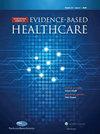Are results from randomized trials in anesthesiology robust or fragile? An analysis using the fragility index.
Q3 Medicine
International Journal of Evidence-Based Healthcare
Pub Date : 2020-03-01
DOI:10.1097/XEB.0000000000000200
引用次数: 12
Abstract
AIM In anesthesiology, the findings from randomized controlled trials often underpin guidelines influencing clinical decision-making and therefore directly affect patient care. The aim of this study is to evaluate the fragility index and fragility quotient of randomized controlled trials published in the eight highest ranked anesthesiology journals. In addition, we assess the extent to which risk of bias scores, loss to follow-up, Web of Science Citation Index, and journal impact factor influence fragility index and fragility quotient. METHODS We included randomized trials published between 2014 and 2016 from the eight highest ranking anesthesiology journals based on Clarivate Analytics' Science Citation Index and Google Scholar Metrics: Anesthesiology subcategory. We included journals that published general anesthesia topics and omitted specialty anesthesia journals. The fragility index and fragility quotient for all included trials were calculated. Risk of bias for each trial was evaluated using the Cochrane 'risk of bias' Tool 2.0. RESULTS One hundred and thirty one randomized control trials were included in this analysis. The median fragility index was 3 (interquartile range 1.0-5.5) with a fragility quotient of 0.03 (interquartile range 0.01-0.08). In 11% (14/131) of trials, the number of patients lost to follow-up was greater than the corresponding fragility index. Weak correlations were found between fragility index and total sample size (r = 0.13) and between fragility index and event frequency (r = 0.19). A near-negligible correlation was found between 5-year impact factor and fragility index (r = -0.03) and, similarly, between fragility index and Science Citation Index (r = -0.05). Ten trials were at high risk of bias with the randomization process found to be the domain at the highest risk of bias. CONCLUSION In assessing the fragility of randomized controlled trials published in the top eight anesthesiology journals, our study suggests that statistically significant results in these journals are disconcertingly fragile. The median fragility index calculated from our 131 primary studies reveals that only three nonevents must be replaced with events to negate statistical significance. Although a current scale does not exist for fragility index ranges, many trials published by the top journals in anesthesiology are based on concerning methodology and highly fragile outcomes. With small median sample sizes and few patient events characterizing a large number of these trials, many of today's current guidelines and clinical practices may be founded on research containing statistical significance but lacking clinical significance.麻醉随机试验的结果是可靠的还是脆弱的?使用脆弱性指数的分析。
在麻醉学中,随机对照试验的结果通常是影响临床决策的指导方针的基础,因此直接影响到患者的护理。本研究的目的是评估发表在8种排名最高的麻醉学期刊上的随机对照试验的脆弱性指数和脆弱性商数。此外,我们评估了偏倚风险评分、随访损失、Web of Science引文索引和期刊影响因子对脆弱性指数和脆弱性商数的影响程度。方法:我们纳入了2014年至2016年间发表在8种排名最高的麻醉学期刊(基于Clarivate Analytics的科学引文索引和Google Scholar Metrics:麻醉学子类)上的随机试验。我们纳入了发表全身麻醉主题的期刊,而省略了专业麻醉期刊。计算所有纳入试验的脆弱性指数和脆弱性商数。使用Cochrane“偏倚风险”工具2.0评估每个试验的偏倚风险。结果纳入131项随机对照试验。脆弱性指数中位数为3(四分位数范围为1.0-5.5),脆弱性商为0.03(四分位数范围为0.01-0.08)。在11%(14/131)的试验中,失访患者的数量大于相应的脆弱性指数。脆弱性指数与总样本量呈弱相关(r = 0.13),脆弱性指数与事件发生频率呈弱相关(r = 0.19)。5年影响因子与脆弱性指数之间的相关性几乎可以忽略不计(r = -0.03),脆弱性指数与科学引文指数之间的相关性同样可以忽略不计(r = -0.05)。10项试验存在高偏倚风险,随机化过程是偏倚风险最高的领域。结论在评估发表在八大麻醉学期刊上的随机对照试验的脆弱性时,我们的研究表明,在这些期刊上发表的具有统计学意义的结果是令人不安的脆弱性。从我们的131项主要研究中计算出的中位数脆弱性指数显示,只有三个非事件必须被事件取代才能否定统计显著性。虽然目前还没有脆弱性指数范围的量表,但麻醉学顶级期刊发表的许多试验都是基于不可靠的方法和高度脆弱的结果。由于中位样本量较小,并且这些试验中很少有患者事件,因此今天的许多现行指南和临床实践可能建立在具有统计意义但缺乏临床意义的研究基础上。
本文章由计算机程序翻译,如有差异,请以英文原文为准。
求助全文
约1分钟内获得全文
求助全文
来源期刊

International Journal of Evidence-Based Healthcare
Medicine-Health Policy
CiteScore
1.80
自引率
0.00%
发文量
39
期刊介绍:
The International Journal of Evidence-Based Healthcare is the official journal of the Joanna Briggs Institute. It is a fully refereed journal that publishes manuscripts relating to evidence-based medicine and evidence-based practice. It publishes papers containing reliable evidence to assist health professionals in their evaluation and decision-making, and to inform health professionals, students and researchers of outcomes, debates and developments in evidence-based medicine and healthcare.
The journal provides a unique home for publication of systematic reviews (quantitative, qualitative, mixed methods, economic, scoping and prevalence) and implementation projects including the synthesis, transfer and utilisation of evidence in clinical practice. Original scholarly work relating to the synthesis (translation science), transfer (distribution) and utilization (implementation science and evaluation) of evidence to inform multidisciplinary healthcare practice is considered for publication. The journal also publishes original scholarly commentary pieces relating to the generation and synthesis of evidence for practice and quality improvement, the use and evaluation of evidence in practice, and the process of conducting systematic reviews (methodology) which covers quantitative, qualitative, mixed methods, economic, scoping and prevalence methods. In addition, the journal’s content includes implementation projects including the transfer and utilisation of evidence in clinical practice as well as providing a forum for the debate of issues surrounding evidence-based healthcare.
 求助内容:
求助内容: 应助结果提醒方式:
应助结果提醒方式:


